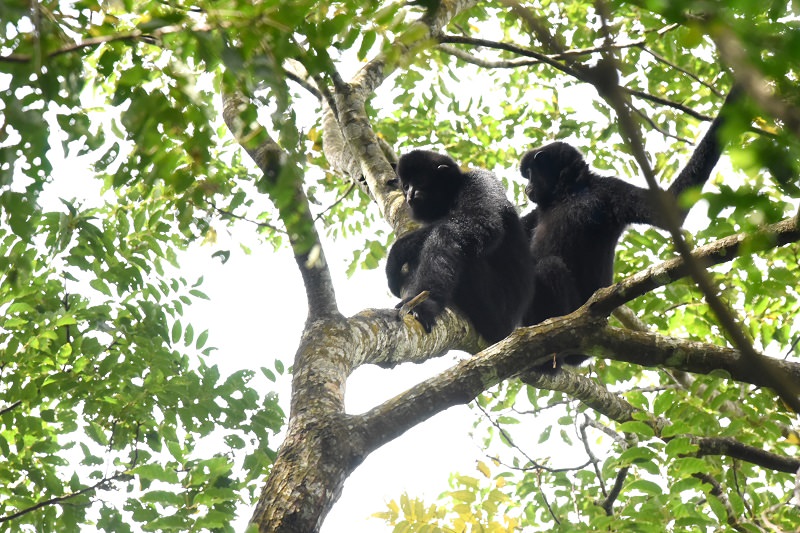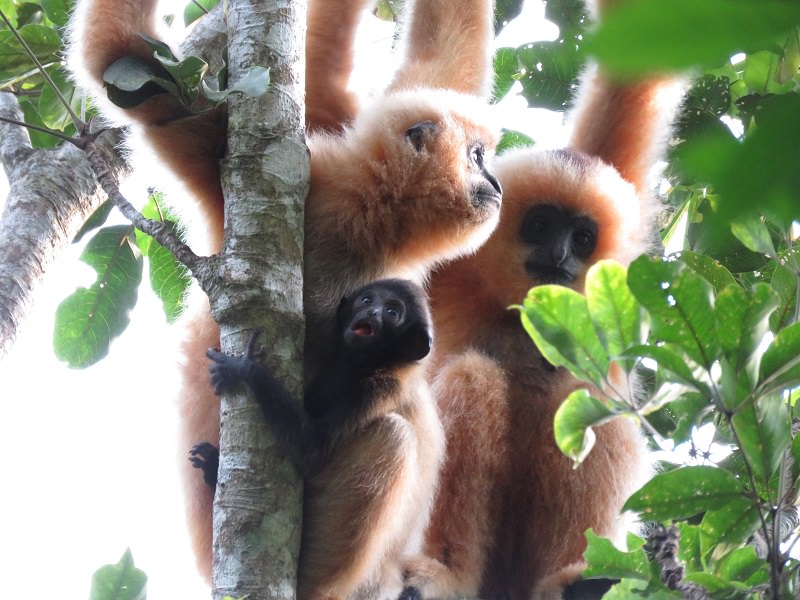Say Hi to Hainan Gibbon!
By Maggie Fok
Assistant Administration Officer of Kadoorie Conservation China
This was the first time for me to conduct a field survey with our team since joining Kadoorie Conservation China (KCC) - a department of KFBG - a year ago. Due to the high demand for physical fitness in fieldwork, it took a while for the team to decide that I, being a girl with limited wilderness experience, could participate in the survey.
Over two months before the survey, our team began to prepare for the Hainan Gibbon annual survey, conducting site inspections and making detailed planning.
What is the Hainan Gibbon?

Two Hainan Gibbon sitting on the branches to observe sites
Hainan Gibbon (Nomascus hainanus) is the rarest primate species in the world, with a global population of less than 30. It is endemic to Hainan Island and is now only found in Bawangling National Nature Reserve (BNNR). The Hainan Gibbon is listed as Critically Endangered by the IUCN Red List of Threatened Species and Class I under National Key Protected Wild Animals. A family typically comprises one male, two females and their offspring.
 Two “mothers” and a juvenile gibbon get along with each other well
Two “mothers” and a juvenile gibbon get along with each other well
Because of serious poaching and destruction of their habitats the population of Hainan Gibbon declined from over 2,000 in the 1950s to the edge of extinction by the 1970s. Only seven to eight individuals roamed Bawangling in 1978. KCC has been collaborating with BNNR to protect the Hainan Gibbon since 2003. From 2005 onwards, KCC has sponsored and trained the Hainan Gibbon monitoring team to effectively protect the gibbons. After 14 years of conservation effort, the gibbon population has doubled; there are now four groups of a minimum of 26 individuals.

Participants in Hainan Gibbon annual census 2016
Photo taken in front of BNNR
The survey was conducted by a team of 50 people, including staff from KCC and BNNR as well as from Hainan’s Yinggeling National Nature Reserve, Jiaxi Provincial Nature Reserve, Baomeiling Provincial Nature Reserve and Yunnan Gaoligongshan National Nature Reserve. The survey was conducted from 23rd to 29th October 2016. KCC provided pre-survey training to the team to ensure everything went smoothly.

The Bawingling road we travelled after Typhoon Sarika
There were still some uncertainties, however, despite our careful preparation because it was the first time the reserve staff had entered the forest since Super Typhoon Sarika devastated the area. I was quite intimidated by the scenes of landslips and fallen boulders. Luckily, all of us reached the designated monitoring base camps safe and sound.
Our four groups of two people set off at 5:00a.m., before dawn, in order to arrive at the listening posts by sunrise, when the Hainan Gibbon usually makes its first call. Although I had hiked at night in Hong Kong before, the forest trails of BNNR presented much more difficulty.
I vividly recall what happened on the first day of the survey. When I was busy studying my location on the map, I heard a sudden call in the distance. I thought it was a birdcall but I was told by the warden that it was the leading call of the Hainan Gibbon. Although I had heard Gibbon calls from audio tracks during the training, they were quite different to my own ears. A male gibbon initiated with a dragging call and then was responded to by a laugh-like call from his female partner.
Let’s listen to the Hainan Gibbons’ fantastic duet: Click ► to play the audio file: Hainan Gibbon pairs’ vocation audio [0:00-0:25 male gibbon’s call’ 0:25-0:32 female gibbon’s call]
The sun rose to the songs of the Hainan Gibbons, giving me the most special and memorable morning of my life. The singing of the Hainan Gibbon usually starts at dawn, and rarely after 11:00 a.m. They would take a nap at noon and look for a tall, straight tree to sleep at sunset. That’s right! They never walk on the ground.
The third gibbon song was very close to us. We ran quickly following the direction of the calls. I could not wait to see them but I was afraid they would disappear even faster by my chasing. With great luck, I saw one of the 26 Hainan Gibbons in the world on the very FIRST day of my very FIRST gibbon survey!!! He swung up and down between the branches and sometimes looked at us to draw our attention so that his family could sneak out of our sight. What a Genius!
I am one of the very few lucky people who have seen this rare species. If we do not take action to conserve the Hainan Gibbon, they will soon be extinct. Wouldn’t it be cruel to let such a thing happen?
Reference:
- Liu et al., 1987. Field Report on the Hainan Gibbon. Pp. 49-50 in Primate Conservation. The Newsletter and Journal of the IUCN/SSC Primate Specialist Group Number 8.

